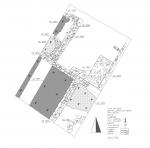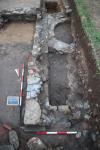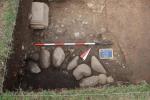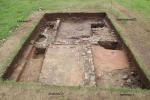Summary (English)
This was the first campaign of excavations in the quarter east of the Cardo Maximus at Luni. A trench (Area 1000) was opened that revealed the razed structures of three rooms and what was possibly an open area, defined as the North-Eastern Sector (Figs. 1-2).
The north and west schist stone walls of room 1 enclosed a tank lined in opus signinum. The tank probably remained in use until the second half of the 5th century, when the laying of another, non-waterproof, floor alongside the _opus _ signinum marked a change in the room’s function. The room underwent further changes between the 5th and 6th centuries: a well was built in the south corner that partially destroyed the tank (Fig. 3) and, subsequently, the well was also obliterated and the room was filled and robbed until being finally abandoned in the second half of the 7th century.
Room two, was bordered to the north and east by the structures of room 1. It had a paving of small cut stones bonded with mortar and finished with a layer of smoothed mortar. Modern digging had cut into part of the room and this made it possible to examine the floor’s make up, constituted by layers of a clay matrix and cobblestones, and the foundations of the north wall that the floor abutted. The excavations reached 1.08 m below ground level at which point water from the water table appeared. The interesting finds date the construction of the floor and associated structures to between the beginning and the third quarter of the 1st century B.C. The structural relationships between room 2 and rooms 1 and 3 suggest that their construction was contemporaneous.
Although room 3 was only partially excavated, it was possible to record the plan and suggest that some sort of craft working activity took place there (Fig. 4).
The room had schist stone walls with an entrance at least 1.05 m wide in the east wall. The southern part of the room was occupied by a circular structure (diam. 1.32 m), paved internally with opus signinum. The north part of the room was paved with cement mixed with stones.
The room’s function changed in the central decades of the 6th century A.D. when the entrance was blocked and the tank filled with a layer of clay.The north-eastern sector of Area 1000 was obliterated by a greyish-black clay layer, which contained abundant building materials, pottery, bone and metal (iron and bronze) fragments. The finds suggest the layer formed in the first half of the 7th century A.D.
This level obliterated a series of structures and layers of late antique date (5th-7th century A.D.), including a north-south wall and a sort of “L” shaped base of uncertain function. The complexity of the overlying stratigraphy prevented the identification of any stratigraphy relating to earlier phases.
- Stefano Genovesi – Università degli Studi di Pisa, Dipartimento di Civiltà e Forme del Sapere
- Paolo Sangriso – Università degli Studi di Pisa, Dipartimento di Civiltà e Forme del Sapere.
- Simonetta Menchelli - Università degli Studi di Pisa Dipartimento di Civiltà e Forme del Sapere.
Director
- Marinella Pasquinucci - Università degli Studi di Pisa, Dipartimento di Civiltà e Forme del Sapere.
Team
Research Body
- Università degli Studi di Pisa, Dipartimento di Civiltà e Forme del Sapere.
Funding Body
- Università degli Studi di Pisa






![Download [PDF]](/excavation/skins/fasti/images/results/download_sml.png)


